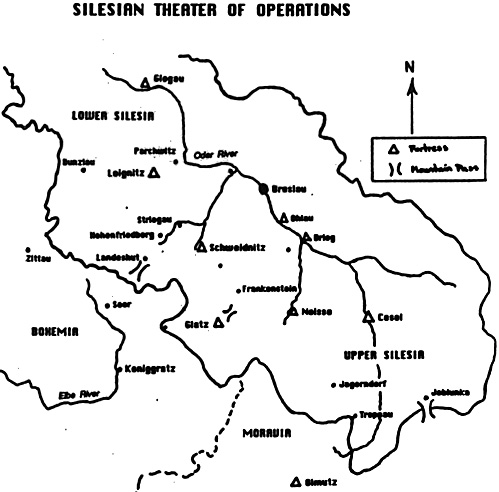The Silesian Campaign of 1745
Frederick fully expected the coming campaign to be staged entirely inside Silesia. The Austrians would invade, full of confidence after their success in Bohemia the previous year. The problem would be in determining where the Austrians would invade. The mountains dividing Silesia from Bohemia could be traversed through any number of mountain passes. Frederick decided that he could not defend the whole province with his battered and meager forces. So he decided to concentrate his troops in northern Silesia and hope that he could repair his army before the coming spring campaign season.
In April 1745, Austrian forces under Batthyany invaded and occupied Bavaria for the third time since the outbreak of the War of Austrian Succession. Charles Albert of Bavaria died that year and the title of Holy Roman Emperor would soon revert to Hapsburg control (Francis of Lorraine).
In May of 1745, Charles advanced his army of 40,000 Austrians and 19,000 Saxons into Silesia via Landeshut. Frederick chose not to defend the mountain defiles leading into Silesia, according to the conventional wisdom of the day. Instead, he withdrew and concentrated his forces around the fortress city of Schweidnitz.
Frederick intended to lure the Austrians out of the mountains and onto the Silesian plain, where the Prussian army would have the advantage in battle. Frederick had to give Charles the impression that the Prussians would not fight in order to spring the trap, so he hid his troops in low-lying ground and spread rumors of a retreat to bait the trap. Frederick also employed a double spy, an Italian servant of Prince Charles, to tell the Austrians that Frederick was concerned about his supply lines to Breslau and might retreat to that city. Charles swallowed the bait and the Austrians descended from the Silesian foothills on June 3, 1745 near the town of Hohenfriedberg.
On June 4, the Prussians attacked and routed the Saxon contingent on the Austrian left at 6:30 A.M., then turned and defeated the Austrians two hours later. The later action was punctuated by the spectacular charge of the Prussian Bayreuth Dragoon regiment, which rode down twenty battalions of Austrians-and captured 2,500 men and 67 standards.
Hohenfriedberg is probably the battle that established Frederick as a "great" general and raised the reputation of the Prussian cavalry arm to new heights. The Austrians and Saxons regrouped and lost again at Soor on September 30, 1745 and again at Kesselsdorf on December 15, 1745. A British threat to sever financial aid finally drove the Austrians to the bargaining table and they signed the Treaty of Dresden on Christmas Day, ending the war and recognizing Prussian sovereignty over Silesia.
Silesian Theater of Operations Map

More Second Silesian War
- Second Silesian War: Introduction
Second Silesian War: Bohemia 1744
Second Silesian War: Silesia 1745
Back to Seven Years War Asso. Journal Vol. VI No. 2 Table of Contents
Back to Seven Years War Asso. Journal List of Issues
Back to Master Magazine List
© Copyright 1992 by James E. Purky
This article appears in MagWeb (Magazine Web) on the Internet World Wide Web.
Other military history articles and gaming articles are available at http://www.magweb.com